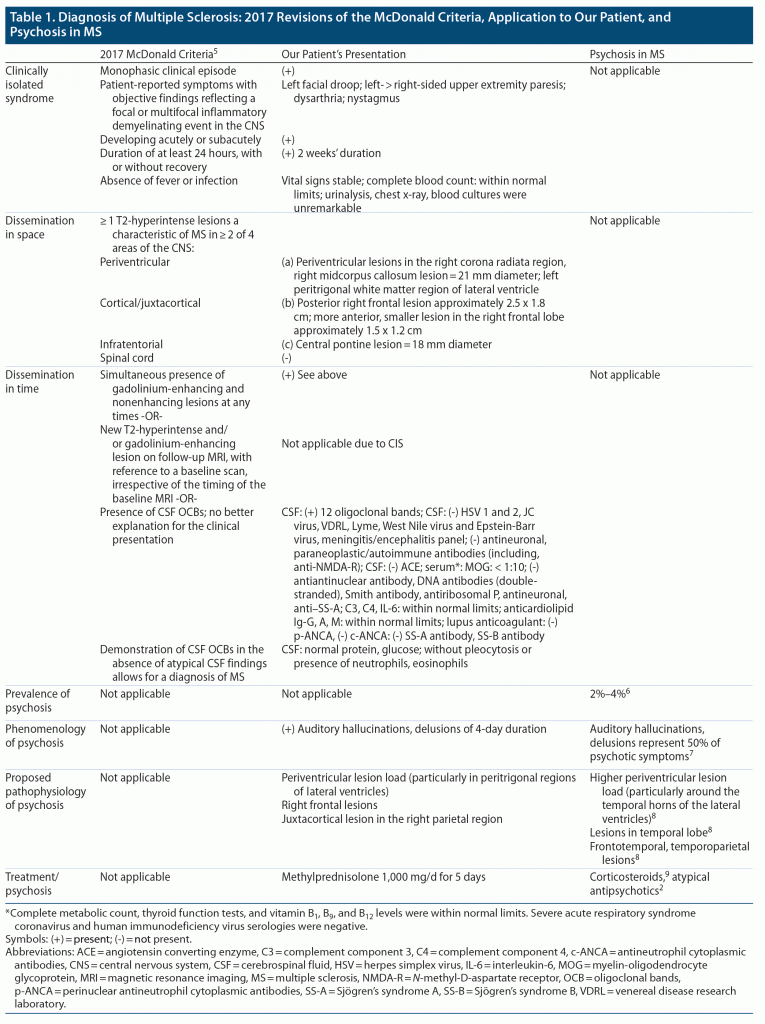
This work may not be copied, distributed, displayed, published, reproduced, transmitted, modified, posted, sold, licensed, or used for commercial purposes. By downloading this file, you are agreeing to the publisher’s Terms & Conditions.
Case Report
A Case of Psychosis in a Patient Concurrently Diagnosed With Multiple Sclerosis Treated Successfully With Corticosteroids
Published: July 25, 2023
Multiple sclerosis (MS) is an autoimmune, inflammatory demyelinating disease of the central nervous system.1 While uncommon, the prevalence of psychosis in MS (MS-P) has been reported in between 2% and 4% of patients, compared with 0.5% and 1% in the general population.2 We present the case of a patient with no prior psychiatric/medical history, with acute-onset left facial droop and other stigmata of MS with subacute onset of psychosis, who was ultimately diagnosed with MS-P.
Case Report
The patient was a 27-year-old man with no prior psychiatric history who presented to the emergency department (ED) with religious/paranoid delusions and new-onset auditory hallucinations 4 days prior. The patient denied alcohol or illicit substance use, which was confirmed by blood alcohol level and urine drug screen. Two weeks earlier, the patient presented for left facial droop, with further evaluation remarkable for right > left upper extremity weakness with paresthesias and dysarthria. Magnetic resonance imaging (MRI) at that time demonstrated 7 T2 fluid-attenuated inversion recovery white matter hyperintensities, with central pontine and right mid corpus callosum lesions of 18 mm and 21 mm diameter, respectively, both consistent with active disease. As the patient left the ED against medical advice before being treated, he was admitted at this presentation for further evaluation and treatment of likely MS. We were consulted due to the patient’s auditory hallucinations.
On evaluation, the patient continued to endorse auditory hallucinations and paranoid delusions. He denied depressed mood or suicidality/homicidality. The mental status examination was unremarkable, except for the psychotic thought content. He was oriented x 3, while his Brief Psychiatric Rating Scale (BPRS)3 and Mini-Mental State Examination4 scores were 41 and 28, respectively.
Table 12,5–9 provides the patient’s complete medical evaluation, including magnetic resonance imaging (MRI) of the head and cerebrospinal fluid. The latter was remarkable for increased immunoglobulin G index = 1.5, 12 oligoclonal bands, and elevated myelin basic protein = 4.7 ng/mL.
The patient completed a 5-day course of methylprednisolone 1,000 mg/d. We elected to withhold antipsychotics, as the patient was neither lethal nor combative/aggressive. After 4 days, both auditory hallucinations and delusions started to wane, with a BPRS score of 31, and 3 days after methylprednisolone was completed, the patient denied any psychotic symptoms, with a BPRS score of 25. Additionally, all neurologic symptoms resolved. Unfortunately, the patient did not wish to take any medications for MS and was lost to follow-up.
Discussion
While our patient’s psychosis occurred within 2 weeks of MS onset, evidence is divergent about this relationship. For instance, in initial reports of MS-P, neurologic symptoms uniformly preceded psychosis.2 In a later study, only 20.9% of patients had a history of MS at presentation, while 34.1% presented with psychotic symptoms and were concurrently (during the initial workup) diagnosed with MS. Finally, 24.1% of patients had a previous history of psychotic symptoms at presentation.10
MS-P has been purported to be related to its neuropathology in periventricular white matter and temporal/frontotemporal regions.8 As in our patient, MRI characteristics in MS-P include a higher periventricular lesion load (particularly around temporal horns of lateral ventricles) and an association between temporal lobe and frontotemporal/temporoparietal lesions.9 Reportedly, diffuse periventricular lesions are found in 95.6% of cases, predominantly in temporal/frontal regions.10
Despite a well-established dose-related risk of neuropsychiatric side effects of corticosteroids,11,12 we elected not to treat with antipsychotics but began immunosuppressive therapy. The latter is supported by a systematic review of MS-P, which reported immunosuppressive therapy to be significantly more effective than antipsychotics (odds ratio = 9.0).10 Nonetheless, multiple low-dose atypical antipsychotics have also been efficacious in the treatment of MS-P.8
In summary, while uncommon, MS-P can occur throughout the course of the illness. Historically, 90%–100% of MS-P developed after the onset of neurologic symptoms,13,14 although more recent studies indicate that MS-P can precede or be concomitant with MS diagnosis.10 Our patient’s initial presentation of left facial palsy and subsequent psychosis highlights the need for a broad differential diagnosis in the evaluation of these 2 symptoms.
Article Information
Published Online: July 25, 2023. https://doi.org/10.4088/PCC.22cr03428
© 2023 Physicians Postgraduate Press, Inc.
Prim Care Companion CNS Disord. 2023;25(4):22cr03428
Submitted: October 3, 2022; accepted November 30, 2022.
To Cite: Spiegel DR, Ralston M, Sharma SS, et al. A case of psychosis in a patient concurrently diagnosed with multiple sclerosis treated successfully with corticosteroids. Prim Care Companion CNS Disord. 2023;25(4):22cr03428.
Author Affiliations: Department of Psychiatry and Behavioral Sciences, Eastern Virginia Medical School, Norfolk (Spiegel, Ralston, Sharma, Suryadevara).
Corresponding Author: David R. Spiegel, MD, Department of Psychiatry and Behavioral Sciences, Eastern Virginia Medical School, 825 Fairfax Avenue, Norfolk, Virginia 23507 (spiegedr@evms.edu).
Relevant Financial Relationships: Dr Spiegel is in the speaker’s bureau for Allergen, Alkermes, Otsuka, and Intra-Cellular Therapies but has no conflict of interest in preparation of this manuscript. The remainder of the authors have no disclaimer/conflict of interest to report.
Funding/Support: None.
Patient Consent: Consent was verbally received from the patient to publish the case report, and information has been de-identified to protect anonymity.
Quick Links:
$40.00
Buy this Article as a PDF
